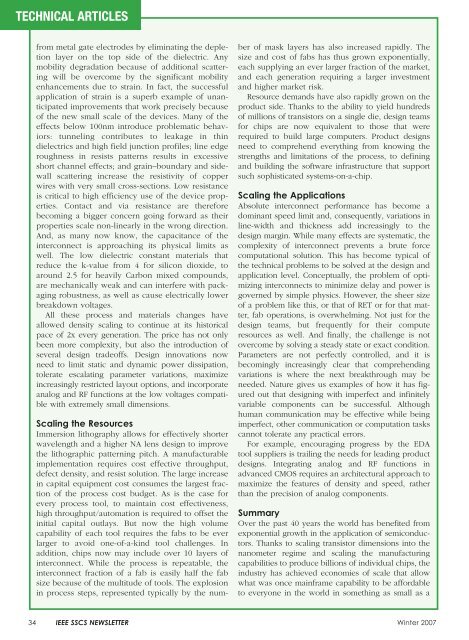The Impact of Dennard's Scaling Theory - IEEE
The Impact of Dennard's Scaling Theory - IEEE
The Impact of Dennard's Scaling Theory - IEEE
- TAGS
- scaling
- www.ieee.org
You also want an ePaper? Increase the reach of your titles
YUMPU automatically turns print PDFs into web optimized ePapers that Google loves.
TECHNICAL ARTICLES<br />
from metal gate electrodes by eliminating the depletion<br />
layer on the top side <strong>of</strong> the dielectric. Any<br />
mobility degradation because <strong>of</strong> additional scattering<br />
will be overcome by the significant mobility<br />
enhancements due to strain. In fact, the successful<br />
application <strong>of</strong> strain is a superb example <strong>of</strong> unanticipated<br />
improvements that work precisely because<br />
<strong>of</strong> the new small scale <strong>of</strong> the devices. Many <strong>of</strong> the<br />
effects below 100nm introduce problematic behaviors:<br />
tunneling contributes to leakage in thin<br />
dielectrics and high field junction pr<strong>of</strong>iles; line edge<br />
roughness in resists patterns results in excessive<br />
short channel effects; and grain–boundary and sidewall<br />
scattering increase the resistivity <strong>of</strong> copper<br />
wires with very small cross-sections. Low resistance<br />
is critical to high efficiency use <strong>of</strong> the device properties.<br />
Contact and via resistance are therefore<br />
becoming a bigger concern going forward as their<br />
properties scale non-linearly in the wrong direction.<br />
And, as many now know, the capacitance <strong>of</strong> the<br />
interconnect is approaching its physical limits as<br />
well. <strong>The</strong> low dielectric constant materials that<br />
reduce the k-value from 4 for silicon dioxide, to<br />
around 2.5 for heavily Carbon mixed compounds,<br />
are mechanically weak and can interfere with packaging<br />
robustness, as well as cause electrically lower<br />
breakdown voltages.<br />
All these process and materials changes have<br />
allowed density scaling to continue at its historical<br />
pace <strong>of</strong> 2x every generation. <strong>The</strong> price has not only<br />
been more complexity, but also the introduction <strong>of</strong><br />
several design trade<strong>of</strong>fs. Design innovations now<br />
need to limit static and dynamic power dissipation,<br />
tolerate escalating parameter variations, maximize<br />
increasingly restricted layout options, and incorporate<br />
analog and RF functions at the low voltages compatible<br />
with extremely small dimensions.<br />
<strong>Scaling</strong> the Resources<br />
Immersion lithography allows for effectively shorter<br />
wavelength and a higher NA lens design to improve<br />
the lithographic patterning pitch. A manufacturable<br />
implementation requires cost effective throughput,<br />
defect density, and resist solution. <strong>The</strong> large increase<br />
in capital equipment cost consumes the largest fraction<br />
<strong>of</strong> the process cost budget. As is the case for<br />
every process tool, to maintain cost effectiveness,<br />
high throughput/automation is required to <strong>of</strong>fset the<br />
initial capital outlays. But now the high volume<br />
capability <strong>of</strong> each tool requires the fabs to be ever<br />
larger to avoid one-<strong>of</strong>-a-kind tool challenges. In<br />
addition, chips now may include over 10 layers <strong>of</strong><br />
interconnect. While the process is repeatable, the<br />
interconnect fraction <strong>of</strong> a fab is easily half the fab<br />
size because <strong>of</strong> the multitude <strong>of</strong> tools. <strong>The</strong> explosion<br />
in process steps, represented typically by the num-<br />
ber <strong>of</strong> mask layers has also increased rapidly. <strong>The</strong><br />
size and cost <strong>of</strong> fabs has thus grown exponentially,<br />
each supplying an ever larger fraction <strong>of</strong> the market,<br />
and each generation requiring a larger investment<br />
and higher market risk.<br />
Resource demands have also rapidly grown on the<br />
product side. Thanks to the ability to yield hundreds<br />
<strong>of</strong> millions <strong>of</strong> transistors on a single die, design teams<br />
for chips are now equivalent to those that were<br />
required to build large computers. Product designs<br />
need to comprehend everything from knowing the<br />
strengths and limitations <strong>of</strong> the process, to defining<br />
and building the s<strong>of</strong>tware infrastructure that support<br />
such sophisticated systems-on-a-chip.<br />
<strong>Scaling</strong> the Applications<br />
Absolute interconnect performance has become a<br />
dominant speed limit and, consequently, variations in<br />
line-width and thickness add increasingly to the<br />
design margin. While many effects are systematic, the<br />
complexity <strong>of</strong> interconnect prevents a brute force<br />
computational solution. This has become typical <strong>of</strong><br />
the technical problems to be solved at the design and<br />
application level. Conceptually, the problem <strong>of</strong> optimizing<br />
interconnects to minimize delay and power is<br />
governed by simple physics. However, the sheer size<br />
<strong>of</strong> a problem like this, or that <strong>of</strong> RET or for that matter,<br />
fab operations, is overwhelming. Not just for the<br />
design teams, but frequently for their compute<br />
resources as well. And finally, the challenge is not<br />
overcome by solving a steady state or exact condition.<br />
Parameters are not perfectly controlled, and it is<br />
becomingly increasingly clear that comprehending<br />
variations is where the next breakthrough may be<br />
needed. Nature gives us examples <strong>of</strong> how it has figured<br />
out that designing with imperfect and infinitely<br />
variable components can be successful. Although<br />
human communication may be effective while being<br />
imperfect, other communication or computation tasks<br />
cannot tolerate any practical errors.<br />
For example, encouraging progress by the EDA<br />
tool suppliers is trailing the needs for leading product<br />
designs. Integrating analog and RF functions in<br />
advanced CMOS requires an architectural approach to<br />
maximize the features <strong>of</strong> density and speed, rather<br />
than the precision <strong>of</strong> analog components.<br />
Summary<br />
Over the past 40 years the world has benefited from<br />
exponential growth in the application <strong>of</strong> semiconductors.<br />
Thanks to scaling transistor dimensions into the<br />
nanometer regime and scaling the manufacturing<br />
capabilities to produce billions <strong>of</strong> individual chips, the<br />
industry has achieved economies <strong>of</strong> scale that allow<br />
what was once mainframe capability to be affordable<br />
to everyone in the world in something as small as a<br />
34 <strong>IEEE</strong> SSCS NEWSLETTER Winter 2007




